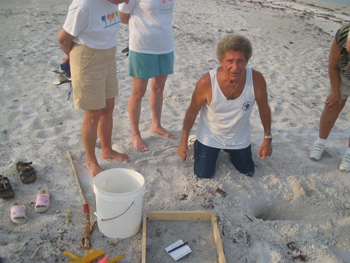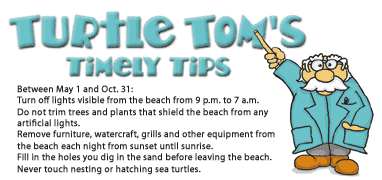Turtle Tom Van Ness an Island legend

PHOTO PROVIDED BY AMITW
Turtle Tom Van Ness is seen here
checking a hatched turtle nest to get a count on the number of
eggs and hatchlings that made it safely into the Gulf waters.
Turtle nesting season is literally just around the corner. It will officially begin on May 1.
This year, it’ll be a bit of an adjustment to think about sea turtle nesting without Turtle Tom Van Ness.
He passed away over the weekend after a long battle with mesothelioma.
Van Ness has been almost a fixture here since he joined Anna Maria Island Turtle Watch as a volunteer in 1996.
“I had just taken on the sea turtle nesting permit holder’s job, and I was a little shy of volunteers,” Anna Maria Island Turtle Watch Director Suzi Fox said. “Tom said he’d help run the three-mile section that runs along Coquina and Bradenton Beach.”
Fox said Tom Van Ness would back his truck into the Cortez parking lot with a thermos of coffee.
“He’d watch the runners, and occasionally he’d yell out, ‘Hey, want to join a group of people to watch turtles every morning,’” she recalled.
A dozen volunteer walkers, many still active today, joined AMITW as a result of Turtle Tom’s early morning recruiting efforts.
“That was back when it wasn’t uncommon to have 12 nests down there in one day,” Fox said. “We’d have to cage every one of them because of lighting problems.”
Fox said Tom would sit by the nests when they were ready to hatch and gather a crowd.
“Some people came here every summer and sought out Tom to sit by the nests with him,” she said. “He’d educate them about the marvels of sea turtles and the threats they face,” she said.
Both children and adults were drawn to Van Ness, and hundreds of visitors left the Island after their vacations with a love for these marine reptiles they got from Van Ness, according to Fox.
“People brought blankets to sit on and bug spray to ward off the mosquitoes and no-see ‘ums,” Fox said. “We used to say Tom was holding court.
She said that whenever anyone called, she would tell them Tom was sitting at a nest that might hatch that night.
“In a soft, quiet voice Tom would weave tales about turtle stories, and people would learn to save them.
“Some would bring the next generation for Tom to teach,” she said.
Turtle Tom will continue his teaching in The Sun each nesting season as we continue to run Turtle Tom’s Timely Tips, which will be a combination of Tom’s timeless knowledge and new information from AMITW.


